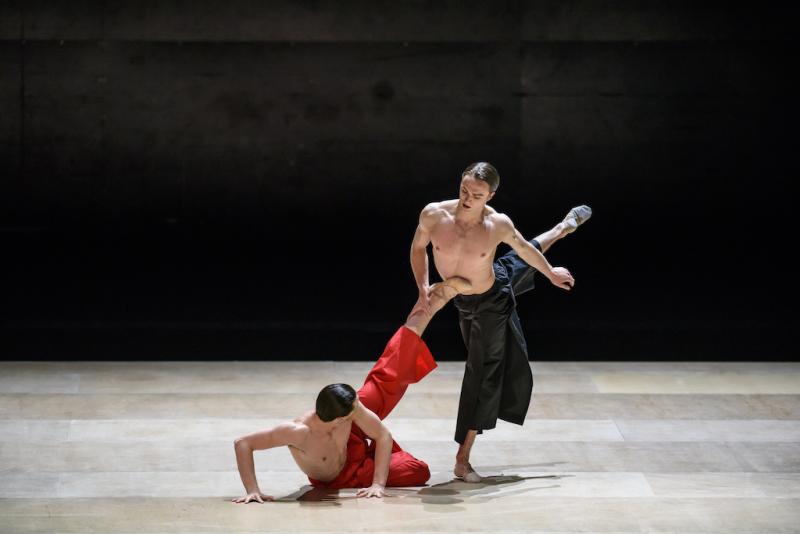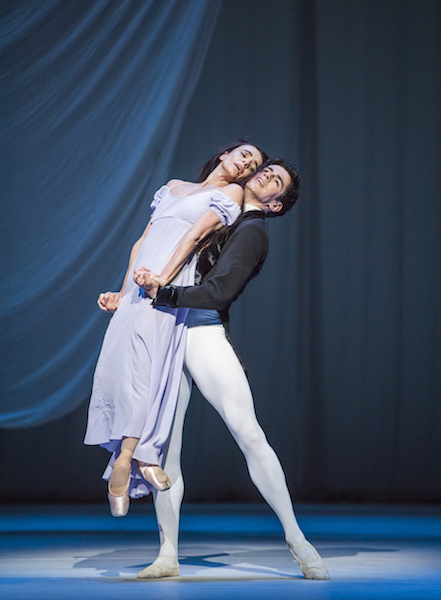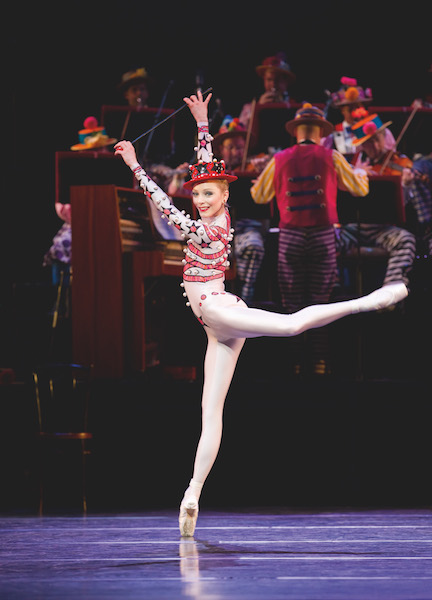Obsidian Tear / Marguerite and Armand / Elite Syncopations, Royal Opera House review - an evening of high-performance mismatch | reviews, news & interviews
Obsidian Tear / Marguerite and Armand / Elite Syncopations, Royal Opera House review - an evening of high-performance mismatch
Obsidian Tear / Marguerite and Armand / Elite Syncopations, Royal Opera House review - an evening of high-performance mismatch
Fine dancing, but these three ballets have nothing to say to each other

One day someone will come up with an algorithm for the perfectly balanced triple bill. Until then ballet directors will have to make do with hit or miss. The Royal Ballet’s latest three-part offering would appear to tick the boxes: something old, something new-ish, and something just for fun.
The best comes first, with a first revival of Wayne McGregor’s Obsidian Tear, a work created two years ago for an all-male ensemble. As is often the case with this choreographer, nothing is simple, not even the title. Are we talking ripping tears or crying tears? Both, it turns out. The black, shiny, super-hard volcanic rock is a component of surgical blades, and shards of obsidian can be naturally tear-shaped. File that away for your next quiz night.
I had believed Esa-Pekka Salonen to be a conductor but he turns out to be an equally top-notch composer
But words are only the start of the puzzle. It’s also left to the audience to work out the anthropological landscape. Who or what are the nine men on stage? Are they friends or enemies, samurai or foot soldiers, ancient or modern, gay or straight? The costumes don’t offer many clues. The two lead guys are in sarong-style skirty things (main picture), while the others sport a mishmash of fashion faux pas including a shift dress, trackies, and a kind of bra top.
It’s the music that tells you this is serious. I had believed Esa-Pekka Salonen to be a conductor but he turns out to be an equally top-notch composer, continuing the Debussy-Takemitsu trajectory. A haunting piece for solo violin, Lachen verlernt (stunningly played by Vasko Vassilev) segues into a big, meaty and ultimately thrilling symphonic poem, Nyx, inspired by the Greek personification of darkness.
 McGregor’s response to its tonal drama looks like nothing he has done before. Gone is the snake-spined hyper-kineticism, in its place a gestural language that suggests something ancient. The movement is fuller and rounder, with flowing arms and a flowery coiling of hands. You wonder if the piece in its atavistic way is addressing gender issues. At one point two men engage in a pas de deux which presents the beefier and bigger dancer in a frankly feminine way, with supported arabesques and yearning lifts. The effect is startling, and surprisingly touching.
McGregor’s response to its tonal drama looks like nothing he has done before. Gone is the snake-spined hyper-kineticism, in its place a gestural language that suggests something ancient. The movement is fuller and rounder, with flowing arms and a flowery coiling of hands. You wonder if the piece in its atavistic way is addressing gender issues. At one point two men engage in a pas de deux which presents the beefier and bigger dancer in a frankly feminine way, with supported arabesques and yearning lifts. The effect is startling, and surprisingly touching.
When eventually six guys gang up on one of the skirted protagonists and throw him over a cliff, you see Obsidian Tear for what it is: a 21st century Rite of Spring, with maleness, not fecundity, as its focus.
The perfumed précis that is Marguerite and Armand looked sickly and pale alongside that one, despite its being neither of those things. Frederick Ashton made this one-acter in 1963 as a vehicle for the company’s surprise star pairing – the 43-year-old Margot Fonteyn and 24-year-old Soviet tearaway Rudolf Nureyev. Much fuss was made at the time over Fonteyn’s age: Ashton even inserted a faltering step which, though it overtly related to the failing health of the courtesan in Dumas’ story, was widely read as a comment on Fonteyn’s failing powers. How times change.
 Alessandra Ferri took the role on Saturday night, and she is about to turn 55. Of the five ballerinas who have been sanctioned to dance the work in London since the Sixties, she is the most Fonteyn-like in her lyricism. Hers is not a big performance – it’s fragile and vulnerable, a quiet tragedy. Partnered by the fine-limned Federico Bonelli (pictured above right with Ferri, image Tristram Kenton), hers is as near-perfect a performance as one could wish. Framed by kinder ballets, it could have been memorable.
Alessandra Ferri took the role on Saturday night, and she is about to turn 55. Of the five ballerinas who have been sanctioned to dance the work in London since the Sixties, she is the most Fonteyn-like in her lyricism. Hers is not a big performance – it’s fragile and vulnerable, a quiet tragedy. Partnered by the fine-limned Federico Bonelli (pictured above right with Ferri, image Tristram Kenton), hers is as near-perfect a performance as one could wish. Framed by kinder ballets, it could have been memorable.
But Elite Syncopations was clearly the audience choice of the night – and yes, it is fun, with its onstage ragtime band in silly hats, the dancers immaculate in their spray-on psychedelic Lycra. At times the stage looks like an explosion of M&Ms. Perhaps it’s sourpussery to find it all a bit dated, but I can’t think Kenneth MacMillan really intended it to last much beyond the Seventies (Sarah Lamb, pictured left by Johan Persson). Were he alive to revise it, I’d bet he’d make the women’s solos less kittenish, less pert. As he agreed in 1975, Elite could have gone on at the Palladium. Enough said.
rating
Share this article
The future of Arts Journalism
You can stop theartsdesk.com closing!
We urgently need financing to survive. Our fundraising drive has thus far raised £49,000 but we need to reach £100,000 or we will be forced to close. Please contribute here: https://gofund.me/c3f6033d
And if you can forward this information to anyone who might assist, we’d be grateful.

Subscribe to theartsdesk.com
Thank you for continuing to read our work on theartsdesk.com. For unlimited access to every article in its entirety, including our archive of more than 15,000 pieces, we're asking for £5 per month or £40 per year. We feel it's a very good deal, and hope you do too.
To take a subscription now simply click here.
And if you're looking for that extra gift for a friend or family member, why not treat them to a theartsdesk.com gift subscription?
more Dance
 'We are bowled over!' Thank you for your messages of love and support
Much-appreciated words of commendation from readers and the cultural community
'We are bowled over!' Thank you for your messages of love and support
Much-appreciated words of commendation from readers and the cultural community
 R:Evolution, English National Ballet, Sadler's Wells review - a vibrant survey of ballet in four acts
ENB set the bar high with this mixed bill, but they meet its challenges thrillingly
R:Evolution, English National Ballet, Sadler's Wells review - a vibrant survey of ballet in four acts
ENB set the bar high with this mixed bill, but they meet its challenges thrillingly
 Like Water for Chocolate, Royal Ballet review - splendid dancing and sets, but there's too much plot
Christopher Wheeldon's version looks great but is too muddling to connect with fully
Like Water for Chocolate, Royal Ballet review - splendid dancing and sets, but there's too much plot
Christopher Wheeldon's version looks great but is too muddling to connect with fully
 iD-Reloaded, Cirque Éloize, Marlowe Theatre, Canterbury review - attitude, energy and invention
A riotous blend of urban dance music, hip hop and contemporary circus
iD-Reloaded, Cirque Éloize, Marlowe Theatre, Canterbury review - attitude, energy and invention
A riotous blend of urban dance music, hip hop and contemporary circus
 How to be a Dancer in 72,000 Easy Lessons, Teaċ Daṁsa review - a riveting account of a life in dance
Michael Keegan-Dolan's unique hybrid of physical theatre and comic monologue
How to be a Dancer in 72,000 Easy Lessons, Teaċ Daṁsa review - a riveting account of a life in dance
Michael Keegan-Dolan's unique hybrid of physical theatre and comic monologue
 A Single Man, Linbury Theatre review - an anatomy of melancholy, with breaks in the clouds
Ed Watson and Jonathan Goddard are extraordinary in Jonathan Watkins' dance theatre adaptation of Isherwood's novel
A Single Man, Linbury Theatre review - an anatomy of melancholy, with breaks in the clouds
Ed Watson and Jonathan Goddard are extraordinary in Jonathan Watkins' dance theatre adaptation of Isherwood's novel
 Peaky Blinders: The Redemption of Thomas Shelby, Rambert, Sadler's Wells review - exciting dancing, if you can see it
Six TV series reduced to 100 minutes' dance time doesn't quite compute
Peaky Blinders: The Redemption of Thomas Shelby, Rambert, Sadler's Wells review - exciting dancing, if you can see it
Six TV series reduced to 100 minutes' dance time doesn't quite compute
 Giselle, National Ballet of Japan review - return of a classic, refreshed and impeccably danced
First visit by Miyako Yoshida's company leaves you wanting more
Giselle, National Ballet of Japan review - return of a classic, refreshed and impeccably danced
First visit by Miyako Yoshida's company leaves you wanting more
 Quadrophenia, Sadler's Wells review - missed opportunity to give new stage life to a Who classic
The brilliant cast need a tighter score and a stronger narrative
Quadrophenia, Sadler's Wells review - missed opportunity to give new stage life to a Who classic
The brilliant cast need a tighter score and a stronger narrative
 The Midnight Bell, Sadler's Wells review - a first reprise for one of Matthew Bourne's most compelling shows to date
The after-hours lives of the sad and lonely are drawn with compassion, originality and skill
The Midnight Bell, Sadler's Wells review - a first reprise for one of Matthew Bourne's most compelling shows to date
The after-hours lives of the sad and lonely are drawn with compassion, originality and skill
 Ballet to Broadway: Wheeldon Works, Royal Ballet review - the impressive range and reach of Christopher Wheeldon's craft
The title says it: as dancemaker, as creative magnet, the man clearly works his socks off
Ballet to Broadway: Wheeldon Works, Royal Ballet review - the impressive range and reach of Christopher Wheeldon's craft
The title says it: as dancemaker, as creative magnet, the man clearly works his socks off
 The Forsythe Programme, English National Ballet review - brains, beauty and bravura
Once again the veteran choreographer and maverick William Forsythe raises ENB's game
The Forsythe Programme, English National Ballet review - brains, beauty and bravura
Once again the veteran choreographer and maverick William Forsythe raises ENB's game

Add comment